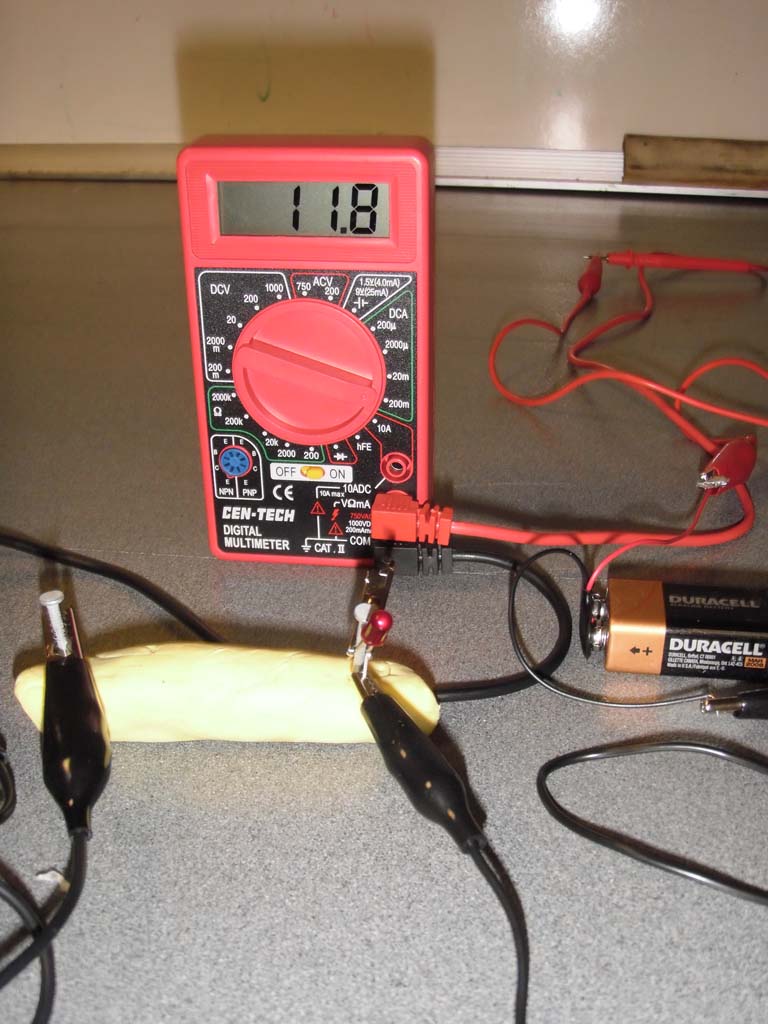Resistance depends on shape.

A resistor made of playdoh
Resistance depends on shape.

A resistor made of playdoh
Introduction
Playdoh is a salt dough which conducts electricity.Material
Playdoh
A digital voltmeter
9 volt battery and battery holder.
Light emitting diode
6 alligator clip leads
Nails
Optional
A buzzer (a regular 3 volt buzzer will work fine it does not have to be piezoelectric.)
Wire stripper
aluminum foil
Assembly
Install the 9 volt battery into its holder, strip 1 cm of insulation from the ends of the red and black wires coming out of the holder.
You may have to wrap aluminum foil around all the wire leads leads from bulbs to give the alligator clips a good grip.
To Do and Notice
Roll playdoh into a cylinder the size of your little finger.
Stick two nails into the far ends of the playdoh fingers.
Clip a 9 volt battery onto the nails. Measure the current, I, in amps flowing through the playdoh. To do this you will have to break the circuit and place the current meter in series with the playdoh.
Use a voltmeter to measure the voltage, V, between the nails.
Ohms law can be used to calcuate the resistance in ohms of the playdoh. R = V/I.
Cut the playdoh in half (keeping the same diameter) and repeat the measurement, to find the resistance of half the playdoh finger.
Use the playdoh resistor in a circuit to light the LED. Squish the playdoh to change its length and thickness and observe how the LED changes brightness.
Make the piezoelectric buzzer buzz using the playdoh as a resistor.
What's Going On?
Playdoh, as a salt dough, it is an electrical conductor, it has resistance. In the salt dough positive ions move from the plus terminal of the battery to the minus, negative ions move from the minus terminal to the plus.
A playdoh shape has resistance. The resistance, R, depends on the length, L, and the cross sectional area, A, of the playdoh resistor.
The playdoh itself has a property independent of its shape called its resistivity, p.
The resistance, R, of a cylinder of playdoh is related to resistivity, p, length, L, and area, A.
R = p L/A
As the cylinder gets longer at the same cross sectional area the resistance increases linearly with length.
As the area of the cylinder doubles at the same length the resistance is cut in half.
So What?
It's important to notice the difference between the intrinsic properties of a material like resistivity which are independent of shape, and the extrinsic properties like resistance that depend on shape.
When resistors are added in series, like two cylinders added together one after the other, the resistors add. R = R1 + R2
When resistors are added in parallel, like two cylinders added side by side, the resistance decreases. Two identical resistors placed side by side have a total resistance that is half of either one of them.
1/R = 1/R1 + 1/R2
Going Further
The nails in the salt dough make a battery and create a voltage, this is why you cannot use the resistance measurement scale built in to the meter.
Here is the circuit with the buzzer.
|
Scientific Explorations with Paul Doherty |
|
19 Oct 2011 |